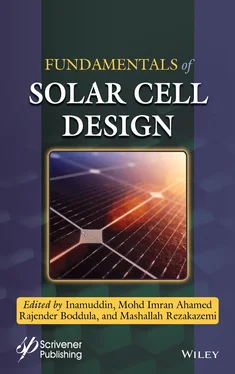2.4.5 Plasmonic Photoelectrochemical Cells
The plasmonic electrodes can enhance the performance of PEC devices for electricity generation as well as water splitting by using more light. The plasmonic electrodes have more advantages than doped or dye sensitized electrodes. The PEC devices have lower efficiency upto 1%–5% [77]. The plasmonic TiO2 cell deposited with gold plasmonic nanoparticles at top surface has shown light to energy conversion efficiency of about 0.01%– 0.02% [78]. The photosensitization of plasmonic nanoparticles Lee et al . have made plasmonic photoanode using gold nanorod ceiled with semiconducting TiO 2for solar to hydrogen (H 2) generation and achieved efficiency about 40% under visible light [88] Plasmonic Au nanoparticles act as a photosensitizer in PEC devices. This technology is still at laboratory scale. The device configuration and modifications in photoactive layers are needed to improve the efficiency in PEC cells [80].
2.4.6 Plasmonic Quantum Dot (QD) Solar Cells
The plasmonic quantum dot solar cells use less material and hence they can offer more cheap solar energy conversion. There is an optimum coupling between electron excitations and plasmons under illumination of light to get best possible performance of PV device that depends on geometry and device design [81]. The high internal quantum efficiency about close to 100% has been achieved in CdSe quantum dot based photodetectorss but an are capable of reaching very high internal quantum efficiencies of close to 100%, but they have external quantum efficiency about only 1% [83]. Lin et al . have demonstrated GaAs PV cell with colloidal CdS quantum dot and achieved efficiency of 18.9% [82]. The plasmonic solar cell made up of PdS QD and Ag nanocubes has enhanced conversion efficiency from 4.45% to 6.03%. The efficiency of 8.09% was achieved with Au plasmonic Au NPs under light with broader wavelengths [84–86]. More studies and efforts are required to make this technology viable at commercial applications.
2.4.7 Plasmonic Perovskite Solar Cells
Organic and inorganic perovskite nanostructures have shown promising prediction in solar cells due their high quantum efficiency and charge transport properties. The plasmonic perovskite solar cell using core-shell structure of TiO 2and Ag nanoparticles has shown efficiency of 16.3% [87–89]. The perovskite solar cell prepared using silver plasmonic nanoparticles at the back side of perovskite layer has shown enhanced photocurrents [90–91]. The perovskite solar cell with Au nanoparticles as fixed core and dielectric SiO 2as tunable shell configuration has shown conversion efficiency of 19.42% [92–94]. This technology has promising future to develop next generation high efficiency solar cells to generate clean energy.
2.4.8 Plasmonic Hybrid Solar Cells
Plasmonic hybrid nanostructures offer more absorption of light in multijunction PV cells. The hybrid plasmonic cells include the earth abundant photoactive layers and cheap plasmonic metal nanoparticles as scattering elements. The organic or inorganic materials can be used as photoactive layer to increase the coupling of sunlight into photoactive material for enhancing light absorption. The hybrid plasmonic solar cell with Ag nanoparticles in TiO 2/benzoic-acid-fullerene bishell (Ag@TiO 2@Pa) has shown conversion efficiency of 20.2%. The enhanced light absorption and carrier extraction of devices are responsible for better performance of PV device [88]. Zhang et al . demonstrated a hybrid plasmonic cell by incorporating silver plasmonic nanoparticles at back side in silicon solar cell and achieved 69% enhancement in photocurrents with light. The plasmonic organic solar cell using Au quantum dots and localized surface plasmons has demonstrated an enhancement in efficiency upto 13% [89].
2.5 Conclusion and Future Aspects
Nanoscience and nanotechnology provide the potential to enhance energy efficiency through materials engineering by tuning its optical and electrical properties. The very thin and optically thick absorbers can make the revolution for larger light absorption and hence high efficiency in plasmonic solar cells. Plasmoinc effect of metallic nanostructures is important in nanophotonics that permit a confinement and manipulation of sunlight at nanoscale. Solar cell technology should be more cheap, eco-friendly, and highly efficient to generate clean electricity. Plasmonic nanostructures such as metal nanoparticle (Ag, Au, Al, and Cu) or thin film (ultra metallic film) can serve as light harvesting antennas in solar energy conversion devices. Plasmonic nanostructures can be can be used directly as photoactive layer or integrated in integrating with existed solar cell technology to increase the absorption and efficiency. There are main three ways to use plasmonic nanostructures in PV device as the top of the surface, integration with photoactive layer, or at the back side of PV cell. Plasmonic PV cells provide enhanced PV properties with various mechanisms such as more trapping of sunlight, injection of hot electrons, enhancement in local electromagnetic (e-m) field, and light scattering by local surface plasmons. They have been achieved efficiency from lower to high about 33.5%. There are still many challenges to develop plasmonic solar cell technology at commercial applications. The properties such as absorption, work function, and plasmonic resonance frequency in metal nanostructures as well as semiconductor energy band gap are important parameters to get better performance in plasmonic solar cells. The interface between plasmonic nanostructure and photoactive material decides the charge and energy transfer mechanism. Tuning all the optical and electrical properties and interface engineering are challenging task and thus it required sophisticated fabrication and characterization tools. A better understanding on the surface plasmon effects would make this technology more efficient for developing next generation solar cells as well as clean fuels.
Authors are thankful to CUG Gandhinagar for providing Non-NET fellowship to TS. Authors are also thankful to Dr. Mukesh Ranjan and Dr. J. H. Markna for fundamental discussion on plasmonic solar cells.
1. N S Lewis, Toward cost-effective solar energy use. Science , 315: 798–801, 2007.
2. H. B. Gray, Powering the plant with solar fuel. Nat Chem. , 1:7, 2009.
3. K Sivula, Metal oxide photoelectrodes for solar fuel production, surface traps, and catalysis. The J Phy Chem Letters, 4: 1624–1633, 2013.
4. Zhang JZ, Ultrafast Studies of Electron Dynamics in Semiconductor and Metal Colloidal Nanoparticles: Effects of Size and Surface. Acc. Chem. Res. 30: 423–429, 1997.
5. William Shockley and Hans J. Queisser, Detailed Balance Limit of Efficiency of p-n Junction Solar Cells. Journal of Applied Physics. 32:3, 510–519, 1961.
6. White, T. P., & Catchpole, K. R., Plasmon-enhanced internal photoemission for photovoltaics: Theoretical efficiency limits. Applied Physics Letters , 101 (7), 2012.
7. T. Shiyani and T. Bagchi, Hybrid nanostructures for solar energy conversion applications. Nanomaterials and Energy , 9:1–8, 2020.
8. Yu, P., Yao, Y., Wu, J., Niu, X., Rogach, A. L., & Wang, Z., Effects of Plasmonic Metal Core-Dielectric Shell Nanoparticles on the Broadband Light Absorption Enhancement in Thin Film Solar Cells. Scientific Reports , 7 (1), 2017.
9. Mubeen S, Lee J, Singh N, Krämer S, Stucky GD, Moskovits M, An autonomous photosynthetic device in which all charge carriers derive from surface plasmons. Nat Nanotechnol. , 8: 247–251, 2013.
Читать дальше












